Abstract
We examined the growth, carbon and nitrogen response of container-grown 2-0 red pine (Pinus densiflora) and black pine (P. thunbergii) seedlings at different types of fertilization. Red pine and black pine seedlings were treated with 0.3% or varying rates of water-soluble foliar fertilizer and a slow-release solid compound fertilizer. Root collar diameter and height of both pine seedlings were not significantly different among fertilizer types, while significantly higher in the fertilization than in the control treatments (P < 0.05). The greatest dry mass of the seedling was observed in the varying rates of foliar fertilization. Carbon concentration among the seedling components was generally higher in foliage or stem than in roots, but that of seedling components was not affected by fertilization types. Nitrogen concentration of seedling components was not significantly different among fertilization types, but significantly greater (P < 0.05) in the fertilization than in the control treatments. These results indicate that morphological characteristics and carbon and nitrogen status of container-grown red pine and black pine seedlings responded similarly between slow-release solid compound fertilizer and water-soluble fertilizer.
Introduction
Sufficient supply of nutrient in container seedlings showed better survival and growth compared with less fertilized container seedlings (Landis et al. Citation1989; Munson and Timmer Citation1990; Dumroese Citation2003; Juntunen et al. Citation2003; Kim et al. Citation2009). Application of water-soluble fertilizers is the most common practice in container seedling production because foliar fertilization can be used to recharge nutrient-depleted seedlings in containers (Landis et al. Citation1989; Oliet et al. Citation2004; Korea Forest Research Institute Citation2007; Kim et al. Citation2009). However, there is a risk of nutrient leaching, as large volumes of irrigation water are used (Juntunen et al. Citation2003). In addition, nutrients derived from fertilizers can contaminate surface or ground water (Landis et al. Citation1989; Juntunen et al. Citation2003).
Varying rates of fertilization may help minimize risks of seedling damage from over-fertilization because fertilizer inputs are matched to plant demands of growth development processes (Dumroese Citation2003). It is possible to increase the efficiency of nutrient use of seedlings and decrease the total amount of applied nutrients by applying nutrients according to growth demands (Dumroese et al. Citation2005). Also, incorporating fertilizer directly into the container growing media has been suggested as a new practice to produce container seedlings (Hasse et al. Citation2002), although it was believed that such a practice would result in toxicity due to direct contact with the root system (Hasse et al. Citation2002). The use of slow-release fertilizer could decrease the total nutrient load (Oliet et al. Citation2004).
Although containerized seedlings must be supplied with sufficient nutrients to obtain good seedling growth (Landis et al., Citation1989; Jackson et al., Citation2007), there is little information for the growth and nutrition of seedlings at various types of fertilization related to container cultivation of red pine and black pine seedlings in Korea (Kim et al. Citation2009; Jeong et al. Citation2010). The objective of this study was to determine the response of growth, carbon and nitrogen in containerized red pine and black pine seedlings receiving various types of fertilization.
Materials and methods
The experiment was conducted in a greenhouse at the Gyeongnam National University of Science and Technology. Red pine and black pine seeds were obtained from a local seed source and sown on 13 March 2008 into containers having a volume of 250 cm3 in each cavity (40 cavities®). Both pine seedlings were grown on benches of greenhouses in containers filled with 1:1:1 (V:V:V) peat moss:vermiculite:perlite medium. The seedlings were irrigated as needed to prevent plant water stress for the study period. Red pine and black pine seedlings for the first growing season (2008) were applied three times by 0.3% foliar fertilization.
Red pine and black pine seedlings for the second growing season (2009) were treated with three different types of fertilization. Two levels (0.3% or varying rates) of water-soluble fertilizer (Planta Products® 20N:20P2O5:20K2O plus micro-elements) and one slow-release solid compound fertilizer (12N: 16P2O5: 4K2O UF compound fertilizer®) were applied for the growing season. The foliar fertilization was applied (25 ml/seedling) by two levels of foliar fertilizer with top-dressing over 10 applications (4 May, 17 May, 1 June, 15 June, 29 June, 13 July, 26 July, 7 August, 23 August, 14 September 2009) during the growing season. Varying rates of foliar fertilizer involved also 10 applications of 0.2% in the initial phase (4 May, 17 May), 0.5% in the middle phase (1 June, 15 June, 29 June, 13 July, 26 July, 7 August), and 0.2% in the late phase of the growing season (23 August, 14 September) through the growing season, respectively. However, slow-release solid compound fertilizer of 2 g per each seedling was applied only one time (4 May 2009). This amount was generally used for incorporation into growing media of container seedlings (Landis et al. Citation1989).
Nine red pine and black pine seedlings were lifted randomly from fertilization treatments of each container on 26 October 2009. Roots were rinsed in tap water to remove soil, and seedlings were separated into component of foliage, stem and roots. All fresh seedlings were dried in a forced-air oven at 65°C for 48 hours. Seedling components of each treatment were combined and ground to pass 0.04 mm mesh in a mortar. Carbon and total nitrogen concentration from the ground materials were determined on an elemental analyzer (CE Instruments EA1110 Elemental Analyzer, ThermoQuest Italia S.P.A. Italy). Total nitrogen content of seedling components was calculated by multiplying dry weight by nitrogen concentration.
Data were analyzed by two-way analysis of variance (ANOVA) to determine the significance of main effects [tree species (S), fertilizer type (F)] and their interactions (S × F). The model describing the data analysis is as follows:
Data were analyzed by using the general linear model procedure in SAS (SAS Institute Inc. Citation2003). Where appropriate, treatment means were compared using Tukey's test and a significance level of P = 0.05 was chosen.
Results
Morphological characteristics of seedlings
Root collar diameter and height of container seedlings were not significantly different between red pine and black pine seedlings, while they were significantly higher (P < 0.05) in the fertilization than in the control treatments ( ). However, the root collar diameter and height were not significantly different among fertilizer types ( ). The greatest dry mass of the seedling was observed in the varying rates of foliar fertilization. The foliage mass among the seedling components was generally higher than the stem or root mass of the seedlings ( ). Shoot/root ratio of seedlings was significantly greater (P < 0.05) in the fertilization than in the control treatments. Dry mass of seedling components of both tree seedlings was not significantly (P > 0.05) different except for root mass ( ).
Figure 1. Root collar diameter and height of red pine and black pine seedlings at various types of fertilization. The same letter on each bar (mean ± S.E.) within each treatment indicates no significant difference according to Tukey's test at P = 0.05. PD: Pinus densiflora, PT: Pinus thunbergii, UF: slow release solid fertilization, 0.3%: 0.3% foliar fertilization, VR: varying rates of foliar fertilization, C: control.
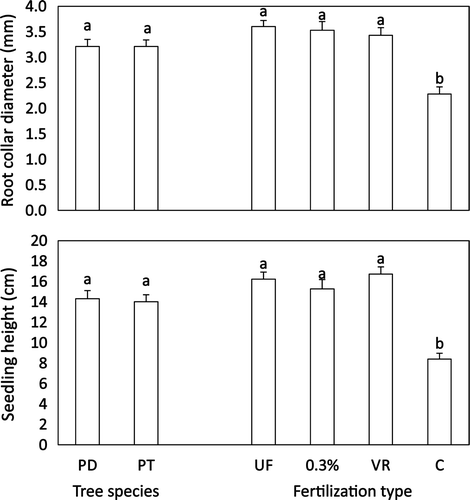
Figure 2. Dry mass of red pine and black pine seedlings at various types of fertilization. The same letter on each bar (mean ± S.E.) within each treatment indicates no significant difference according to Tukey's test at P = 0.05. PD: Pinus densiflora, PT: Pinus thunbergii, UF: slow release solid fertilization, 0.3%: 0.3% foliar fertilization, VR: varying rates of foliar fertilization, C: control.
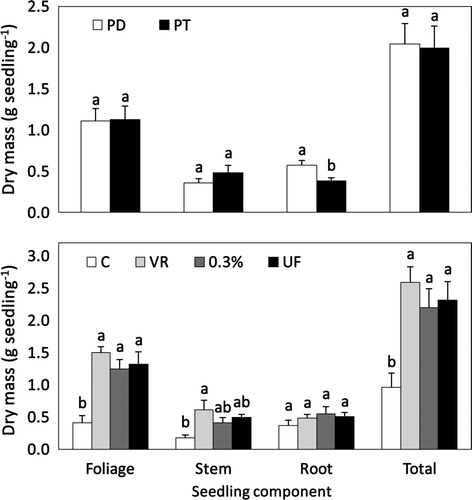
Figure 3. Shoot/root ratio of red pine and black pine seedlings at various types of fertilization. The same letter on each bar (mean ± S.E.) within each treatment indicates no significant difference according to Tukey's test at P = 0.05. PD: Pinus densiflora, PT: Pinus thunbergii, UF: slow release solid fertilization, 0.3%: 0.3% foliar fertilization, VR: varying rates of foliar fertilization, C: control.
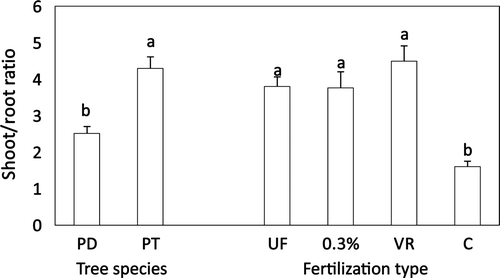
Table 1. P-value of ANOVA of root collar diameter, height, dry mass, and shoot/root ratio of red pine and black pine seedlings in various types of fertilization.
Carbon and nitrogen response of seedlings
Carbon concentration among the seedling components was generally higher in foliage or stem than in roots, but was not affected by fertilization type ( ). Carbon concentration in roots was significantly higher in the black pine than in the red pine (P < 0.05), while other seedling components such as foliage or stem were not significantly different (P > 0.05) between both pine species ( ). Nitrogen concentration in the seedlings was greatest in foliage, followed by roots or stem ( ). Nitrogen concentration of seedling components was significantly greater (P < 0.05) in the fertilization than in the control treatments, but that of seedlings was not significantly different (P > 0.05) among fertilization types. Total nitrogen content of seedlings was closely related to seedling dry mass ( ). In addition, there was a significant fertilization effect among the nitrogen content of seedling components (P < 0.05) in both pine seedlings. Nitrogen content of seedlings was highest in foliage, followed by roots and stem.
Figure 4. Carbon concentration of red pine and black pine seedlings at various types of fertilization. The same letter on each bar (mean ± S.E.) within each treatment indicates no significant difference according to Tukey's test at P = 0.05. PD: Pinus densiflora, PT: Pinus thunbergii, UF: slow release solid fertilization, 0.3%: 0.3% foliar fertilization, VR: varying rates of foliar fertilization, C: control.
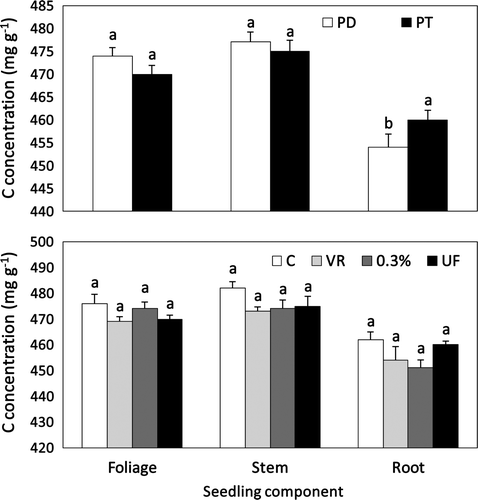
Figure 5. Nitrogen concentration of red pine and black pine seedlings at various types of fertilization. The same letter on each bar (mean ± S.E.) within each treatment indicates no significant difference according to Tukey's test at P = 0.05. PD: Pinus densiflora, PT: Pinus thunbergii, UF: slow release solid fertilization, 0.3%: 0.3% foliar fertilization, VR: varying rates of foliar fertilization, C: control.

Figure 6. Nitrogen content of red pine and black pine seedlings at various types of fertilization. The same letter on each bar (mean ± S.E.) within each treatment indicates no significant difference according to Tukey's test at P = 0.05. PD: Pinus densiflora, PT: Pinus thunbergii, UF: slow release solid fertilization 0.3%: 0.3% foliar fertilization, VR: Varying rates of foliar fertilization, C: control.
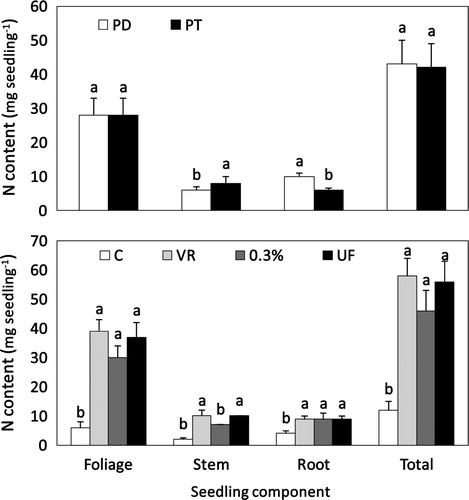
Table 2. P-value of ANOVA of carbon and nitrogen response of red pine and black pine seedlings in various types of fertilization.
Discussion
Seedling morphological attributes were improved regardless of various types of fertilization. Seedling height ranged from 8.4 cm for the control to 16.2 cm for the slow-release solid compound fertilizer. Root collar diameter ranged from 2.3 mm for the control to 3.6 mm for the slow-release compound fertilizer treatments. Total seedling biomass ranged from 0.96 g for the control to 2.59 g for the varying rates of foliar fertilization treatments. The greatest dry mass of the seedling was observed in the varying rates of foliar fertilization, but these growth factors were not significantly affected by fertilization types. In addition, growth response of both pine seedlings in slow-release solid compound fertilizer or varying rates of foliar fertilizer was comparable to 0.3% of foliar fertilizer. This result indicated that slow-release solid compound fertilizer may act as critical nutrient sources for growth and nutrition of both pine seedlings, although greater quantities of nutrient during the initial phase of seedling growth are released.
Growth and dry mass of red pine and black pine seedlings were greater in the fertilization than in the control treatments. This could be attributed to increased nutrient availability following fertilization (Landis et al. Citation1989; William and Stroupe Citation2002; Dumroese et al. Citation2005; Kim et al. Citation2009). In addition, fertilization may have a direct effect on both photosynthetic capacity and biomass allocation, which resulted in establishment of greater foliage mass and enhance growth. In this study, the seedlings in fertilization treatments had up to about 1.6–1.9 times the root collar diameter and height growth of the seedling of the control treatments. Foliage mass of the seedlings was also much greater in fertilization treatments (3.0 times for 0.3% – 3.7 times for varying rates of foliar fertilization) than that of the control seedlings, while root mass of the seedling was slightly different (1.3 times for varying rates – 1.5 times for 0.3% of foliar fertilization). This indicates that the dry mass allocation of seedlings could be regulated by physiological responses, such as allocation of resources between woody and photosynthetic compounds (Gough et al. Citation2004). In addition, more dry mass allocation to roots at the expense of foliage on the control treatment could be due to phenotypic adjustment to nutrient stress.
Shoot/root ratio of seedlings was not significantly different (P > 0.05) among fertilization types, but significantly greater in the fertilization than in the control treatments. This greater shoot/root ratio in fertilizer treatments may reflect increase in nutrient availability following fertilization because applications of fertilizer usually promote shoot growth and discourage root growth (Jackson et al. Citation2007). While shoot/root ratio in both pine seedlings was not affected by fertilization types, low shoot/root ratio of red pine seedlings (2.53) compared with black pine seedlings (4.30) could be due to the difference of genetic factors related to carbon allocations of tree components between both pine species.
Carbon concentrations of seedling components were not affected by (P > 0.05) the fertilization types. However, carbon concentration in the control (462–482 mg g−1) was generally higher than that in the fertilization (451–475 mg g−1) treatments. Carbon concentration of tree components was generally greater in nutrient-deficient conditions compared with trees grown in better nutrient conditions because of low mineral concentration of tree components or the difference of carbon allocation (Peri et al. Citation2010), although the inter- and intra-specific variation of carbon concentration is determined by genetic and environmental factors (Bert and Danjon Citation2006; Zhang et al. Citation2009; Peri et al. Citation2010). Another study reported that carbon concentration in black pine seedlings was a poor indicator of response to fertilization (Kim et al. Citation2009).
Nitrogen concentration in seedling components was not related to fertilization types or tree species, while nitrogen concentration was significantly (P < 0.05) higher in the fertilization than in the control treatments. Foliage nitrogen concentration (23.6 mg g−1 for 0.3% − 28.3 mg g−1 for slow-release solid fertilization) among three fertilization types yield foliage nitrogen concentrations of optimum range (15 mg g−1 to 25 mg g−1) of coniferous seedlings suggested by Landis et al. (Citation1989). This result suggests that these fertilization types in containerized red pine and black pine seedlings were sufficient to maintain the optimum range of nitrogen concentrations. In addition, the nitrogen concentrations of other seedling components such as stem and roots showed a similar response. Low nitrogen concentration found in the control treatment may be deficient and limiting to seedling growth (Landis et al. Citation2005). Although nutrient composition of seedlings varies between different species (Landis et al. Citation2005), nitrogen concentration of both pine seedlings was not affected in this study. Total nitrogen content of seedlings was not affected by fertilization types, but the content was closely related to seedling dry mass at fertilization type and tree species.
In summary, the growth, carbon and nitrogen response of red pine and black pine seedlings grown in containers were not significantly influenced by various types of fertilization. Root collar diameter, height, nitrogen concentration and nitrogen content of red pine and black pine seedlings were similar among fertilization types. The results indicate that the application of slow-release solid fertilizers was comparable with foliar fertilization of water-soluble fertilizer and could be contributed to critical nutrient sources for growth and nutrient of containerized red pine and black pine seedlings.
Acknowledgements
This study was carried out with the support of Forest Science & Technology Projects (Project No. S120808L 1301104) provided by the Korea Forest Service.
References
- Bert , D and Danjon , D . 2006 . Carbon concentration variations in the roots, stem and crown of mature Pinus pinaster (Ait.) . For Ecol Manage , 222 : 279 – 295 . doi:10.1016/j.foreco. 2005.10.030
- Dumroese , R K . 2003 . “ Hardening fertilization and nutrient loading of conifer seedlings ” . In National Proceedings: Forest and Conservation Nursery Associations-2002 , Edited by: Riley , L E , Dumroese , R K and Landis , T D . Ogden , UT : USDA Forest Service, Rocky Mountain Research Station . Proceeding RMRS-P-28:31–36
- Dumroese , R K , Parkhurst , J and Barnett , J P . Controlled release fertilizer improves quality of container longleaf pine seedlings . USDA Forest Service, Proceedings RMRS-P-35:3–8 .
- Gough , C M , Seiler , J R and Maier , C A . 2004 . Short-term effects of fertilization on loblolly pine (Pinus taeda L.) physiology . Plant, Cell and Environ , 27 : 876 – 886 .
- Hasse , D L , Trobaugh , J and Rose , R . 2002 . “ Douglas-fir container stock grown with fertilizer-amended media: some preliminary results ” . In National Proceedings: Forest and Conservation Nursery Associations-1999, 2000, and 2001 , Edited by: Dumroese , R K , Riley , L E and Ladis , T D . Ogden , UT : USDA Forest Service, Rocky Mountain Research Station. Proceeding RMRS-P-24:31-32 .
- Jackson , D P , Dumroese , R K , Barnett , J P and Patterson , W B . 2007 . “ Container longleaf pine seedling morphology in response to varying rates of nitrogen fertilization in nursery and subsequent growth after outplanting ” . In National Proceedings: Forest and Conservation Nursery Associations-2006 , Edited by: Riley , L E , Dumroese , R K and Landis , T D . Ogden , UT : USDA Forest Service, Rocky Mountain Research Station . Proceeding RMRS-P-50:114-119
- Jeong , J , Park , J-H , Kim , J-I , Lim , J T , Lee , S-R and Kim , C . 2010 . Effects of container volumes and fertilization on red (Pinus densiflora) and black pine (Pinus thunbergii) seedlings growth . For Sci Tech , 6 : 80 – 86 .
- Juntunen , M L , Hammar , T and Rikala , R . 2003 . Nitrogen and phosphorus leaching and uptake by container birch seedlings (Betula pendula Roth) grown in three different fertilization . New Forests , 25 : 133 – 147 .
- Kim , C , Jeong , J , Moon , T S , Park , J H , Lim , J T , Kim , J I and Goo , G H . 2009 . Growth, carbon and nitrogen status of container grown black pine (Pinus thunbergii) seedlings at various levels of fertilization . J Kor For Soc , 98 : 558 – 562 .
- Korea Forest Research Institute . 2007 . Manual for Production of 2-0 Pine Container Seedlings , Research Report on Korea Forest Research Institute . 45 pp. (in Korean)
- Landis , T D , Tinus , R W , McDonald , S E and Barnett , J P . 1989 . “ Seedling nutrition and irrigation. Vol. 4. The container tree nursery manual ” . In Agricultural Handbook 674 119 pp
- Landis , T D , Haase , D L and Dumroese , R K . Plant nutrient testing and analysis in forest and conservation nurseries. USDA Forest Service, Rocky Mountain Research Station . Proceeding RMRS-P-35:76-83 .
- Munson , A D and Timmer , V R . 1990 . Site-specific growth and nutrition of planted Picea mariana in the Ontario Clay Belt. III. Biomass and nutrient allocation . Can J For Res , 20 : 1165 – 1171 .
- Oliet , J , Olanelles , R , Segura , M L , Artero , F and Jacobs , D F . 2004 . Mineral nutrition and growth of containerized Pinus halepensis seedlings under controlled-release fertilizer . Sci Hort , 103 : 113 – 129 .
- Peri , P L , Gargalione , V , Pastur , G M and Lencinas , M V . 2010 . Carbon accumulation along a stand development sequence of Nothofagus Antarctica forests across a gradient in site quality in Southern Patagonia . For Ecol Manage. , 260 : 229 – 237 . DOI 10.1016/j.foreco.2010.04.27
- SAS Institute Inc . 2003 . SAS/STAT Statistical software. Version 9.1 Cary , NC: SAS publishing
- William , H and Stroupe , M . First-year survival and growth of bareroot and container water oak and willow oak seedlings grown at different levels of mineral nutrition . Proceedings of the Eleventh Biennial Southern Silvicultural Research Conference. Gen. Tech. Rep. SRS-48:338-341 . Edited by: Outcalt , K W .
- Zhang , Q , Wang , C , Wang , X and Quan , X . 2009 . Carbon concentration variability of 10 Chinese temperate tree species . For Ecol Manage , 258 : 722 – 727 . doi:10.1016/j.foreco.2009.05.009